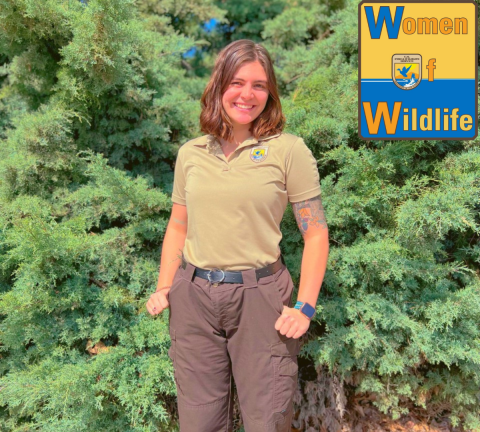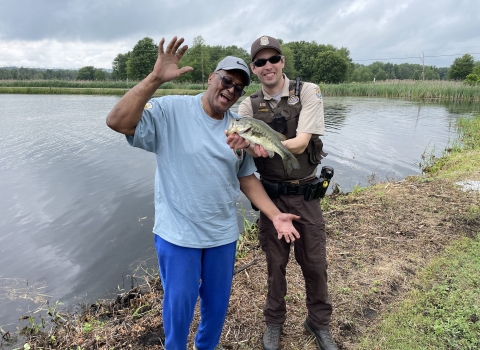A nocturnal little creature inspired Kayla Feist to become a part of the federal organization that protects furry critters and other wildlife.
After helping treat a raccoon at the vet clinic where she worked, Feist said she was “hooked” and immediately decided to volunteer at a wildlife rehabilitation center.
“I spent almost all of my summer there from sunup to sundown, taking care of a variety of Mississippi’s wildlife,” says the proud Mississippi State alumna, where the beloved mascot is a bulldog. “My personal favorites were the opossums and coyotes, though I always thought the coolest was the otters. From there, I found I really liked interacting with people and educating them about the importance of not only our natural wildlife but also the habitats that sustain them.”
Before she transferred to Mississippi State University as a junior, Feist planned to be a veterinarian. She took college courses while in high school in her hometown of Meridian, attended community college, worked full time, and volunteered for local vets, all to make her dream come true.
But after connecting with the raccoon and other wildlife, she decided to take another turn.
She researched academic programs focused on nature and wildlife. She knew as a transfer student she needed to make up some time, increasing her knowledge about the field and possible career opportunities. So, she explored internship opportunities that might complement classroom experiences in Starkville.
“Once [at MSU], I dove in and asked how to get involved because I felt behind as a junior. Most people already had one or two internships under their belt, and I had almost none and no previous conservation knowledge.”
With a little help from an engaged professor, she discovered the U.S. Fish and Wildlife Service’s Pathways Program. Several programs provide current students and recent graduates with practical hands-on job experiences that can lead to established careers within government service.
Internships fall into two categories: U.S. Fish and Wildlife Service federal internships and those offered through nongovernmental partner organizations. The Service appoints interns or fellows through the three Pathways Program components.
The Internship Program targets current students enrolled in high school, college or technical school at least half time. The Recent Graduates Program targets individuals who apply within two years of graduation. The Presidential Management Fellowship Program is for students and recent graduates with an advanced degree.
Candidates become non-permanent employees through all three of these Pathways Programs with the opportunity to be converted to a permanent, term or temporary employee at the end of the program.
“Even after choosing MSU and diving in, I was not sure exactly what the [U.S. Fish and Wildlife Service] was and what it did,” said Feist who grew up in a Navy family. “I even frequently volunteered at Sam D. Hamilton Noxubee National Wildlife Refuge and had little idea.”
Feist found several Pathways opportunities on USAJobs, the website where all federal agencies list their employment opportunities. Just 18 months before she graduated, Feist began her Pathways journey. She started as an intern at the Theodore Roosevelt National Wildlife Refuge Complex and then worked with the Wildlife and Sport Fish Restoration program.
During her internship, she learned “all the ins and outs of the Service” and decided it was her employer of choice. Feist graduated as a proud MSU Bulldog December 2021. She earned a degree in wildlife, fisheries, and aquaculture science, with a concentration in human-wildlife interactions.
In 2020 she joined the Service, and now works within the Science Applications-Migratory Bird program.
“I am here for a reason. I am here to make a difference in the things that I can change because those are the things I can control,” Feist said. “I can make positive impacts through educating others and bringing them not just to the Service, but to conservation as a whole.”
“I want to look back on my career in 60 years and say that I did something, and it made a positive difference on conservation. I think the USFWS provides me many different avenues and opportunities to do that, more so than any other conservation job in my opinion.”
She encourages other college students to explore the Pathways program and the Service, specifically, charging them to “do it.”
“We are dedicated to the future -- and present -- of conservation and are making positive impacts every single day. If you want to be a part of something larger than yourself, there is a place for you here,” she says.
Feist, who is now working toward a masters in conservation education at Mississippi State, explains that a wildlife-related degree isn’t a prerequisite for employment with the Service.
“Even if you don’t have an interest or background in conservation, you don’t need one. You can be interested in data management, administration, finance, geographic information systems, writing, communications, diversity efforts, or anything more. There is a plethora of jobs, and you will be welcome here.”
Editor’s note: During Women’s History Month, the U.S. Fish and Wildlife Service celebrates the accomplishments and commitment of women throughout the organization. The Women of Wildlife, or WOW, story series highlights some of the women serving in the Southeast Region.





